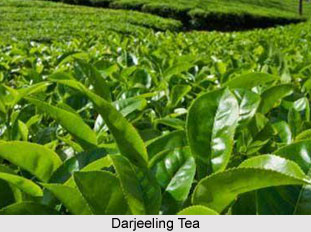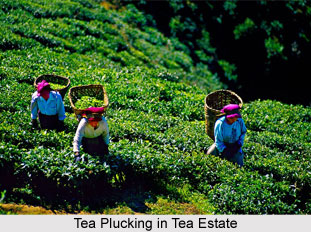 Darjeeling Tea is one of the most cherish possessions of India. The taste and aroma of the tea is unique and immensely delightful. About 17,500 hectares of land in the hills under tea plantation have been given the status of Darjeeling Tea, which are divided into 78 tea estates and by the Tea Board of India. About 50 percent population of the district is involved in producing Darjeeling Tea and produces more than 9 million kg of tea annually. The tea industry forms the backbone of the district economy and the workers engaged in this job are blessed with a good livelihood including facilities like allowances, housing, incentives, statutory benefits, creches for infants of working women, medical facilities, children`s education and many other for the family of workers.
Darjeeling Tea is one of the most cherish possessions of India. The taste and aroma of the tea is unique and immensely delightful. About 17,500 hectares of land in the hills under tea plantation have been given the status of Darjeeling Tea, which are divided into 78 tea estates and by the Tea Board of India. About 50 percent population of the district is involved in producing Darjeeling Tea and produces more than 9 million kg of tea annually. The tea industry forms the backbone of the district economy and the workers engaged in this job are blessed with a good livelihood including facilities like allowances, housing, incentives, statutory benefits, creches for infants of working women, medical facilities, children`s education and many other for the family of workers.
History of Darjeeling Tea Plantation
First plantation of Darjeeling Tea was done by Dr. A Campbell at an altitude of 700 ft. followed by the setting up of an experimental nursery in the year 1845. At Lebong a nursery was planted by the Government in 1847 which paved the way for the huge production and fame of Darjeeling tea. The plantation spans over Darjeeling and Kurseong sub-divisions.
Production and Manufacture of Darjeeling Tea
Darjeeling Tea thrives best at high altitude of about 600 to 2000 meters above sea level and with 50 to 60 centimetres of annual rainfall. Darjeeling fulfils these requirements excellently and thus houses a number of tea estates. Combination of moist and cool climate, slopping terrains and soil of the district renders it the unique muscatel flavour. Orthodox tea manufacture is referred to the original methods that are applied in the manufacture of Darjeeling Tea. Organic tea is produced by utilizing ecologically sustainable practices and natural manure avoiding the use of chemical pesticides and fertilizers. The demand for Organic tea has heightened greatly over time.
 Types of Darjeeling Tea
Types of Darjeeling Tea
Darjeeling tea is further categorized into various types. Black Tea is the most popular variety especially in Western Countries. During its production, the tea leaves are processed to bring out different flavours in them such as flowery, nutty, fruity and spicy. Oolong Tea is another variety in which the leaves are partially fermented and flavours of both black and green teas are retained in it. They possess a fruity aroma and fragrant flavour. Green tea is the favourite of Asian countries since ages. In addition to its beautiful aroma, it also furnishes numerous health benefits. White tea is the finest variety of Darjeeling tea, unparallel in terms of its natural sweetness and subtlety. White tea is produced by just steaming and drying the leaves. Absence of further processing keeps the appearance of the leaves unaltered. Other varieties include Blended Tea, Flavoured Tea, Scented Tea and Seasonal Blends.
Tea Tourism
Owing to the plantation of this exquisite variety of tea, Darjeeling has also developed a new concept of tea tourism. Tea garden bungalows provide accommodation to the tourists and encourage them to experience the serine ambience of the tea gardens and to know about the tea manufacturing processes. Other alluring features of tea tourism are tea plucking session, nature walks, golf, rafting and trekking.
A number of natural factors make Darjeeling tea an unmatched beverage in the world. It is highly admired and relished throughout the globe and a large portion of it is exported in the international market.



















